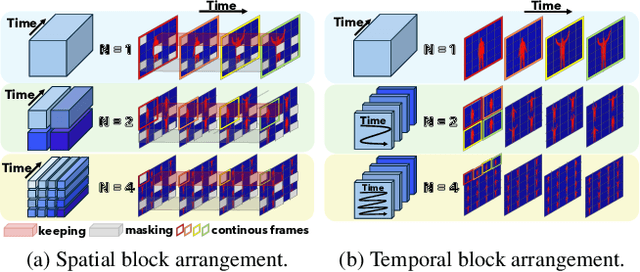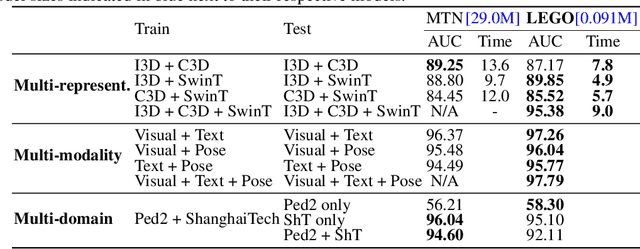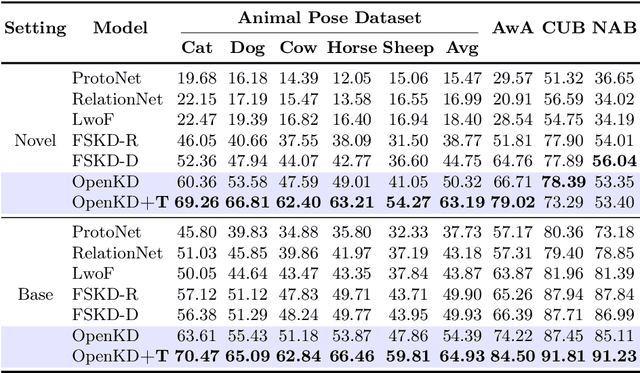Piotr Koniusz
INRIA Grenoble Rhône-Alpes / LJK Laboratoire Jean Kuntzmann
Video Understanding by Design: How Datasets Shape Architectures and Insights
Sep 11, 2025Abstract:Video understanding has advanced rapidly, fueled by increasingly complex datasets and powerful architectures. Yet existing surveys largely classify models by task or family, overlooking the structural pressures through which datasets guide architectural evolution. This survey is the first to adopt a dataset-driven perspective, showing how motion complexity, temporal span, hierarchical composition, and multimodal richness impose inductive biases that models should encode. We reinterpret milestones, from two-stream and 3D CNNs to sequential, transformer, and multimodal foundation models, as concrete responses to these dataset-driven pressures. Building on this synthesis, we offer practical guidance for aligning model design with dataset invariances while balancing scalability and task demands. By unifying datasets, inductive biases, and architectures into a coherent framework, this survey provides both a comprehensive retrospective and a prescriptive roadmap for advancing general-purpose video understanding.
Noise Consistency Regularization for Improved Subject-Driven Image Synthesis
Jun 06, 2025Abstract:Fine-tuning Stable Diffusion enables subject-driven image synthesis by adapting the model to generate images containing specific subjects. However, existing fine-tuning methods suffer from two key issues: underfitting, where the model fails to reliably capture subject identity, and overfitting, where it memorizes the subject image and reduces background diversity. To address these challenges, we propose two auxiliary consistency losses for diffusion fine-tuning. First, a prior consistency regularization loss ensures that the predicted diffusion noise for prior (non-subject) images remains consistent with that of the pretrained model, improving fidelity. Second, a subject consistency regularization loss enhances the fine-tuned model's robustness to multiplicative noise modulated latent code, helping to preserve subject identity while improving diversity. Our experimental results demonstrate that incorporating these losses into fine-tuning not only preserves subject identity but also enhances image diversity, outperforming DreamBooth in terms of CLIP scores, background variation, and overall visual quality.
MATHGLANCE: Multimodal Large Language Models Do Not Know Where to Look in Mathematical Diagrams
Mar 26, 2025Abstract:Diagrams serve as a fundamental form of visual language, representing complex concepts and their inter-relationships through structured symbols, shapes, and spatial arrangements. Unlike natural images, their inherently symbolic and abstract nature poses significant challenges for Multimodal Large Language Models (MLLMs). However, current benchmarks conflate perceptual and reasoning tasks, making it difficult to assess whether MLLMs genuinely understand mathematical diagrams beyond superficial pattern recognition. To address this gap, we introduce MATHGLANCE, a benchmark specifically designed to isolate and evaluate mathematical perception in MLLMs. MATHGLANCE comprises 1.2K images and 1.6K carefully curated questions spanning four perception tasks: shape classification, object counting, relationship identification, and object grounding, covering diverse domains including plane geometry, solid geometry, and graphical representations. Our evaluation of MLLMs reveals that their ability to understand diagrams is notably limited, particularly in fine-grained grounding tasks. In response, we construct GeoPeP, a perception-oriented dataset of 200K structured geometry image-text pairs explicitly annotated with geometric primitives and precise spatial relationships. Training MLLM on GeoPeP leads to significant gains in perceptual accuracy, which in turn substantially improves mathematical reasoning. Our benchmark and dataset establish critical standards for evaluating and advancing multimodal mathematical understanding, providing valuable resources and insights to foster future MLLM research.
Graph Self-Supervised Learning with Learnable Structural and Positional Encodings
Feb 22, 2025



Abstract:Traditional Graph Self-Supervised Learning (GSSL) struggles to capture complex structural properties well. This limitation stems from two main factors: (1) the inadequacy of conventional Graph Neural Networks (GNNs) in representing sophisticated topological features, and (2) the focus of self-supervised learning solely on final graph representations. To address these issues, we introduce \emph{GenHopNet}, a GNN framework that integrates a $k$-hop message-passing scheme, enhancing its ability to capture local structural information without explicit substructure extraction. We theoretically demonstrate that \emph{GenHopNet} surpasses the expressiveness of the classical Weisfeiler-Lehman (WL) test for graph isomorphism. Furthermore, we propose a structural- and positional-aware GSSL framework that incorporates topological information throughout the learning process. This approach enables the learning of representations that are both sensitive to graph topology and invariant to specific structural and feature augmentations. Comprehensive experiments on graph classification datasets, including those designed to test structural sensitivity, show that our method consistently outperforms the existing approaches and maintains computational efficiency. Our work significantly advances GSSL's capability in distinguishing graphs with similar local structures but different global topologies.
Open Eyes, Then Reason: Fine-grained Visual Mathematical Understanding in MLLMs
Jan 11, 2025



Abstract:Current multimodal large language models (MLLMs) often underperform on mathematical problem-solving tasks that require fine-grained visual understanding. The limitation is largely attributable to inadequate perception of geometric primitives during image-level contrastive pre-training (e.g., CLIP). While recent efforts to improve math MLLMs have focused on scaling up mathematical visual instruction datasets and employing stronger LLM backbones, they often overlook persistent errors in visual recognition. In this paper, we systematically evaluate the visual grounding capabilities of state-of-the-art MLLMs and reveal a significant negative correlation between visual grounding accuracy and problem-solving performance, underscoring the critical role of fine-grained visual understanding. Notably, advanced models like GPT-4o exhibit a 70% error rate when identifying geometric entities, highlighting that this remains a key bottleneck in visual mathematical reasoning. To address this, we propose a novel approach, SVE-Math (Selective Vision-Enhanced Mathematical MLLM), featuring a geometric-grounded vision encoder and a feature router that dynamically adjusts the contribution of hierarchical visual feature maps. Our model recognizes accurate visual primitives and generates precise visual prompts tailored to the language model's reasoning needs. In experiments, SVE-Math-Qwen2.5-7B outperforms other 7B models by 15% on MathVerse and is compatible with GPT-4V on MathVista. Despite being trained on smaller datasets, SVE-Math-7B achieves competitive performance on GeoQA, rivaling models trained on significantly larger datasets. Our findings emphasize the importance of incorporating fine-grained visual understanding into MLLMs and provide a promising direction for future research.
When Spatial meets Temporal in Action Recognition
Nov 22, 2024



Abstract:Video action recognition has made significant strides, but challenges remain in effectively using both spatial and temporal information. While existing methods often focus on either spatial features (e.g., object appearance) or temporal dynamics (e.g., motion), they rarely address the need for a comprehensive integration of both. Capturing the rich temporal evolution of video frames, while preserving their spatial details, is crucial for improving accuracy. In this paper, we introduce the Temporal Integration and Motion Enhancement (TIME) layer, a novel preprocessing technique designed to incorporate temporal information. The TIME layer generates new video frames by rearranging the original sequence, preserving temporal order while embedding $N^2$ temporally evolving frames into a single spatial grid of size $N \times N$. This transformation creates new frames that balance both spatial and temporal information, making them compatible with existing video models. When $N=1$, the layer captures rich spatial details, similar to existing methods. As $N$ increases ($N\geq2$), temporal information becomes more prominent, while the spatial information decreases to ensure compatibility with model inputs. We demonstrate the effectiveness of the TIME layer by integrating it into popular action recognition models, such as ResNet-50, Vision Transformer, and Video Masked Autoencoders, for both RGB and depth video data. Our experiments show that the TIME layer enhances recognition accuracy, offering valuable insights for video processing tasks.
Inductive Graph Few-shot Class Incremental Learning
Nov 11, 2024



Abstract:Node classification with Graph Neural Networks (GNN) under a fixed set of labels is well known in contrast to Graph Few-Shot Class Incremental Learning (GFSCIL), which involves learning a GNN classifier as graph nodes and classes growing over time sporadically. We introduce inductive GFSCIL that continually learns novel classes with newly emerging nodes while maintaining performance on old classes without accessing previous data. This addresses the practical concern of transductive GFSCIL, which requires storing the entire graph with historical data. Compared to the transductive GFSCIL, the inductive setting exacerbates catastrophic forgetting due to inaccessible previous data during incremental training, in addition to overfitting issue caused by label sparsity. Thus, we propose a novel method, called Topology-based class Augmentation and Prototype calibration (TAP). To be specific, it first creates a triple-branch multi-topology class augmentation method to enhance model generalization ability. As each incremental session receives a disjoint subgraph with nodes of novel classes, the multi-topology class augmentation method helps replicate such a setting in the base session to boost backbone versatility. In incremental learning, given the limited number of novel class samples, we propose an iterative prototype calibration to improve the separation of class prototypes. Furthermore, as backbone fine-tuning poses the feature distribution drift, prototypes of old classes start failing over time, we propose the prototype shift method for old classes to compensate for the drift. We showcase the proposed method on four datasets.
Less is More: Extreme Gradient Boost Rank-1 Adaption for Efficient Finetuning of LLMs
Oct 25, 2024Abstract:Fine-tuning Large Language Models (LLMs) has become a crucial technique for adapting pre-trained models to downstream tasks. However, the enormous size of LLMs poses significant challenges in terms of computational complexity and resource requirements. Low-Rank Adaptation (LoRA) has emerged as a promising solution. However, there exists a gap between the practical performance of low-rank adaptations and its theoretical optimum. In this work, we propose eXtreme Gradient Boosting LoRA (XGBLoRA), a novel framework that bridges this gap by leveraging the power of ensemble learning. Inspired by gradient boosting, XGBLoRA iteratively learns and merges a sequence of LoRA adaptations to refine model predictions. It achieves better performance than the standard LoRA, while enjoying the computational efficiency of rank-1 adaptations. We provide theoretical analysis to show the convergence and optimality of our approach, and conduct extensive experiments on a range of natural language processing tasks. The results demonstrate that XGBLoRA consistently outperforms standard LoRA and achieves performance comparable to full fine-tuning with significantly fewer trainable parameters. This work advances parameter-efficient fine-tuning for LLMs, and offers a promising solution for adapting LLMs to downstream tasks while optimizing performance and efficiency.
LEGO: Learnable Expansion of Graph Operators for Multi-Modal Feature Fusion
Oct 02, 2024



Abstract:In computer vision tasks, features often come from diverse representations, domains, and modalities, such as text, images, and videos. Effectively fusing these features is essential for robust performance, especially with the availability of powerful pre-trained models like vision-language models. However, common fusion methods, such as concatenation, element-wise operations, and non-linear techniques, often fail to capture structural relationships, deep feature interactions, and suffer from inefficiency or misalignment of features across domains. In this paper, we shift from high-dimensional feature space to a lower-dimensional, interpretable graph space by constructing similarity graphs that encode feature relationships at different levels, e.g., clip, frame, patch, token, etc. To capture deeper interactions, we use graph power expansions and introduce a learnable graph fusion operator to combine these graph powers for more effective fusion. Our approach is relationship-centric, operates in a homogeneous space, and is mathematically principled, resembling element-wise similarity score aggregation via multilinear polynomials. We demonstrate the effectiveness of our graph-based fusion method on video anomaly detection, showing strong performance across multi-representational, multi-modal, and multi-domain feature fusion tasks.
OpenKD: Opening Prompt Diversity for Zero- and Few-shot Keypoint Detection
Sep 30, 2024



Abstract:Exploiting the foundation models (e.g., CLIP) to build a versatile keypoint detector has gained increasing attention. Most existing models accept either the text prompt (e.g., ``the nose of a cat''), or the visual prompt (e.g., support image with keypoint annotations), to detect the corresponding keypoints in query image, thereby, exhibiting either zero-shot or few-shot detection ability. However, the research on taking multimodal prompt is still underexplored, and the prompt diversity in semantics and language is far from opened. For example, how to handle unseen text prompts for novel keypoint detection and the diverse text prompts like ``Can you detect the nose and ears of a cat?'' In this work, we open the prompt diversity from three aspects: modality, semantics (seen v.s. unseen), and language, to enable a more generalized zero- and few-shot keypoint detection (Z-FSKD). We propose a novel OpenKD model which leverages multimodal prototype set to support both visual and textual prompting. Further, to infer the keypoint location of unseen texts, we add the auxiliary keypoints and texts interpolated from visual and textual domains into training, which improves the spatial reasoning of our model and significantly enhances zero-shot novel keypoint detection. We also found large language model (LLM) is a good parser, which achieves over 96% accuracy to parse keypoints from texts. With LLM, OpenKD can handle diverse text prompts. Experimental results show that our method achieves state-of-the-art performance on Z-FSKD and initiates new ways to deal with unseen text and diverse texts. The source code and data are available at https://github.com/AlanLuSun/OpenKD.
 Add to Chrome
Add to Chrome Add to Firefox
Add to Firefox Add to Edge
Add to Edge